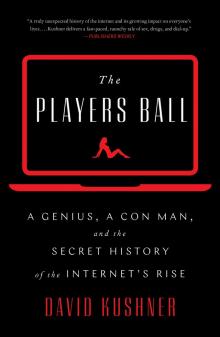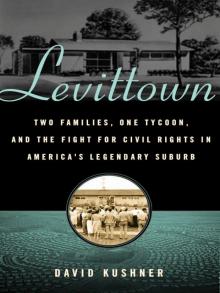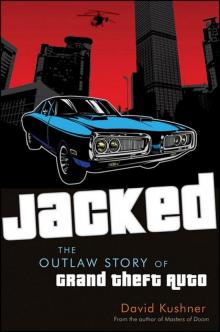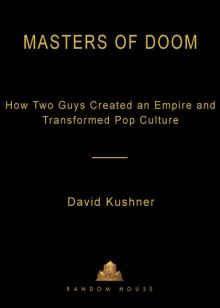- Home
- David Kushner
Jacked: The Outlaw Story of Grand Theft Auto
Jacked: The Outlaw Story of Grand Theft Auto Read online
Contents
Title Page
Copyright
Author's Note
Prologue: Players vs. Haters
1: The Outlaws
2: The Warriors
3: Race 'n' Chase
4: The Gouranga!
5: Eating the Hamster
6: Liberty City
7: Gang Warfare
8: Steal This Game
9: Rockstar Loft
10: The Worst Place in America
11: State of Emergency
12: Crime Pays
13: Vice City
14: Rampages
15: Cashmere Games
16: Grand Death Auto
17: Boyz in the Hood
18: Sex in San Andreas
19: Unlock the Darkness
20: Hot Coffee
21: Adults Only
22: Busted!
23: Bullies
24: Flowers for Jack
25: New York City
Epilogue: Outlaws to the End
Acknowledgments
Notes
Index
To Andy Kushner
This book is printed on acid-free paper.
Copyright © 2012 by David Kushner. All rights reserved
Published by John Wiley & Sons, Inc., Hoboken, New Jersey
Published simultaneously in Canada
Designations used by companies to distinguish their products are often claimed as trademarks. In all instances where John Wiley & Sons, Inc., is aware of a claim, the product names appear in Initial Capital or ALL CAPITAL letters. Readers, however, should contact the appropriate companies for more complete information regarding trademarks and registration.
No part of this publication may be reproduced, stored in a retrieval system, or transmitted in any form or by any means, electronic, mechanical, photocopying, recording, scanning, or otherwise, except as permitted under Section 107 or 108 of the 1976 United States Copyright Act, without either the prior written permission of the Publisher, or authorization through payment of the appropriate per-copy fee to the Copyright Clearance Center, 222 Rosewood Drive, Danvers, MA 01923, (978) 750–8400, fax (978) 646–8600, or on the web at www.copyright.com. Requests to the Publisher for permission should be addressed to the Permissions Department, John Wiley & Sons, Inc., 111 River Street, Hoboken, NJ 07030, (201) 748–6011, fax (201) 748–6008, or online at http://www.wiley.com/go/permissions.
Limit of Liability/Disclaimer of Warranty: While the publisher and the author have used their best efforts in preparing this book, they make no representations or warranties with respect to the accuracy or completeness of the contents of this book and specifically disclaim any implied warranties of merchantability or fitness for a particular purpose. No warranty may be created or extended by sales representatives or written sales materials. The advice and strategies contained herein may not be suitable for your situation. You should consult with a professional where appropriate. Neither the publisher nor the author shall be liable for any loss of profit or any other commercial damages, including but not limited to special, incidental, consequential, or other damages.
For general information about our other products and services, please contact our Customer Care Department within the United States at (800) 762–2974, outside the United States at (317) 572–3993 or fax (317) 572–4002.
Wiley also publishes its books in a variety of electronic formats and by print-on-demand. Some content that appears in standard print versions of this book may not be available in other formats. For more information about Wiley products, visit us at www.wiley.com.
Library of Congress Cataloging-in-Publication Data
Kushner, David, 1968-
Jacked: the outlaw story of Grand Theft Auto/David Kushner.
p. cm.
Includes bibliographical references and index.
ISBN 978-0-470-93637-5 (hardback); ISBN 978-1-118-19792-9 (ebk);
ISBN 978-1-118-19793-6 (ebk); ISBN 978-1-118-19794-3 (ebk)
1. Grand theft Auto games. 2. Video games. I. Title.
GV1469.35.G738K87 2012
794.8—dc23
2011043336
Author's Note
This book is based on more than ten years of research. I first played Grand Theft Auto in 1997 and began reporting on its creators, Rockstar Games, two years later. As the franchise boomed, I chronicled game culture and industry for publications that included Rolling Stone, Wired, the New York Times, GamePro, and Electronic Gaming Monthly, as well as in my first book, Masters of Doom.
My reporting took me across the country and around the world—from the offices of Rockstar in New York to the streets of Dundee, Scotland, where GTA began. There were long days and endless nights at game conventions and start-ups. I spent hundreds (thousands?) of hours playing games. I played Pong with Nolan Bushnell, the founder of Atari, and, for one particularly awesome afternoon in Lake Geneva, Wisconsin, rolled the dice with Gary Gygax, the cocreator of Dungeons & Dragons.
As the industry grew, I saw the controversies rise over violent video games—especially over GTA—and covered both sides of the disputes. I sat with a crying mother in a tiny town in Tennessee, where her sons had just murdered one person and maimed another—and triggered a $259 million lawsuit against Rockstar and others for allegedly inspiring the crime with GTA. I went to Coral Gables, Florida, to visit GTA's chief opponent, Jack Thompson, at his home.
I spoke with leaders from the Entertainment Software Association in Washington, D.C., and went behind closed doors at the clandestine Entertainment Software Ratings Board in New York to see how games are rated. In Iowa City, I sat in a small stuffy room hooked up to electrodes while I played Grand Theft Auto—and university researchers studied my brain. Yeah, it was strange.
Though all of these adventures don't appear explicitly in this book, they inform it. This is a work of narrative nonfiction, a recreation of the story of GTA. The scenes and the dialogue are drawn from hundreds of my own interviews and firsthand observations, as well as thousands of articles, court documents, and TV and radio reports. The Rolling Stone reporter who appears in the book is me.
Over the years since I first visited Rockstar Games, I've interviewed many people at the company including each of the cofounders. Though the current helm at Rockstar declined to participate in this book, I was able to draw freely from my previous interviews with them and speak extensively with those who have left. A few sources didn't want to be identified, due to personal or professional concerns. Others were reluctant to talk, then eager, or eager, then reluctant. In the end, the vast majority went on the record. A funny thing happens when you write a book like this. People start to realize and appreciate that they are part of a larger story, not only their own, but everyone's.
Prologue
Players vs. Haters
How far would you go for something you believe in?
One winter day, Sam Houser was going farther than he'd ever imagined or feared—all the way to Capitol Hill to answer to the Feds. The thirty-four-year-old had achieved the universal dream: rising from nowhere to make his fantasies real. Yet now reality was threatening to take it all away.
A scrappy Brit running an empire in New York City, Sam cultivated the image of the player he had become. Scruffy hair. Shaggy beard. Eyes hidden behind aviator shades. Gripping the wheel of his jet-black Porsche. Buildings towering. Taxis honking. Flipping stations on the radio. Pedal to the metal as the world blurred like a scene from the video game that made him so rich and so wanted: Grand Theft Auto.
GTA, the franchise published by Sam's company, Rockstar Games, was among the most successful and notorious vid
eo games of all time. GTA IV alone would smash the Guinness Record to be the most profitable entertainment release in history—leaving every blockbuster superhero movie and even the final Harry Potter book in its pixilated wake. Players bought more than 114 million copies and shelled out over $3 billion on the titles. The juggernaut helped make video games the fastest-growing segment of the entertainment business. By 2011, the $60 billion global game industry would dwarf music and film box office sales—combined.
GTA revolutionized an industry, defined one generation, and pissed off another, transforming a medium long thought of as kids' stuff into something culturally relevant, darkly funny, and wildly free. It cast players at “the center of their own criminal universe,” as Sam once told me. You were a bad guy doing bad things in fictional cities meticulously riffed from real life: Miami, Vegas, New York, and Los Angeles.
For the mad frat of Brits who invented the game, GTA was a love letter from England to America in all of its fantastic excess: the sex and the violence, the money and the crime, the fashion and the drugs. As the game's phenomenally talented art director Aaron Garbut once told me, the goal was “to make the player feel like he's starring in his own fucked-up Scorsese-directed cartoon.”
Ostensibly, players had to complete a series of missions for a motley crew of gangster bosses: whacking enemies, jacking cars, dealing drugs. Yet even better, players didn't have to play by the rules at all. GTA was a brilliantly open world to explore. There was no high score to hit or princess to save. Players could just steal an eighteen-wheeler at gunpoint, crank up the radio, and floor the gas, taking out pedestrians and lampposts and anything else dumb enough to get in the way of a good time. The fact that players could also hire hookers and kill cops made it controversial and tantalizing.
More personally, GTA made Sam Houser the rock star of his industry. Sam was passionate, driven, and creative, and Time ranked him among the world's most influential people, alongside President Obama, Oprah Winfrey, and Gordon Brown, for “creating tapestries of modern times as detailed as those of Balzac or Dickens.” Variety called GTA “a hit-machine arguably unparalleled in any other part of the media business.” The Wall Street Journal dubbed Sam “one of the leading lights of the video game era. A secretive, demanding workaholic [with] a temperament and a budget befitting a Hollywood mogul.” One analyst compared his company to “the kids on the island in Lord of the Flies.” But the hard work and long hours were all in service of Sam's ultimate mission: to take this maligned and misunderstood medium, video games, and make it as awesome as it could be. But no one had anticipated that making a game about outlaws could seem so outlaw for real. And that's what was bringing him to Washington, D.C., on this cold day.
After years of blaming Grand Theft Auto for inspiring murder and mayhem, politicians had what appeared to be a smoking gun: a hidden sex mini-game in the new GTA. The discovery of the scene, dubbed Hot Coffee, exploded into the industry's biggest scandal ever, the Watergate of video games. Rockstar blamed hackers. Hackers blamed Rockstar. Politicians and parents wanted GTA banned.
Now everyone, it seemed—from the consumers who filed a multimillion-dollar class-action suit over the game to the Federal Trade Commission investigating Rockstar for fraud—wanted the truth. Had Rockstar purposely hidden porn in GTA to cash in? If the company had, its game might be over. As Sam's rival, moral warrior attorney Jack Thompson, warned, “We are going to destroy Rockstar, you can count on that.”
How did this all happen? The answer is the story of a new generation and the game that defined it. As media theorist Marshall McLuhan once said, “The games of a people reveal a great deal about them.” It's hard to understand those who came of age at the turn of the millennium without understanding GTA. Grand Theft Auto marked the awkward adolescence of a powerful medium as it struggled to grow up and find its voice. It was an artifact of the George W. Bush era and the fight for civil liberties.
The fact that it hit during one of the most volatile chapters in the history of media was no accident. It symbolized the freedoms and fears of the strange new universe dawning on the other side of the screens. GTA seemed to split the world into players and haters. Either you played, or you didn't. For the players, jacking a car in the game was like saying, This is our ride now. This is our time behind the wheel. For the haters, it was something foreboding.
As Sam sat before the FTC investigators, the moment brought to mind an e-mail he had sent to a colleague when faced with compromising GTA. “The concept of a glorified shop (walmart) telling us what we can/can't put in our game is just unacceptable on so many levels,” he wrote, “all of this material is perfectly reasonable for an adult (of course it is!), so we need to push to continue to have our medium accepted and respected as a mainstream entertainment platform. We have always been about pushing the boundaries; we cannot stop here.”
1
The Outlaws
Controls
Grim city. Aerial view. A man in black runs along a river as a red sports car chases after him. Suddenly, a white convertible peels up in his path. “Over here, Jack!” shouts a beautiful young British woman behind the wheel. Jack leaps into her car, and she floors it. She has long auburn hair and stylish silver-framed shades. “You didn't know you had a fairy godmother, did you?” she asks, coyly.
“So where are we going, Princess?” Jack asks.
“To the demon king's castle, of course.” She shifts into high gear, speeding through a parking garage to safety.
In 1971, there was no cooler getaway driver than Geraldine Moffat, the actress in this scene from Get Carter, a British crime film released that year. Critics dismissed it, saying, “One would rather wash one's mouth out with soap than recommend it.” Yet as is often the case with anything new and controversial, the fans won out in the end.
The scene of Moffat lounging nude in bed with Michael Caine—a Rolling Stones album propped on the nightstand beside them—epitomized how hip movies could be. Get Carter became a cult classic, and Moffat, one of London's most fashionable stars. She married Walter Houser, a musician who ran the hottest jazz club in England, Ronnie Scott's.
Shortly after Get Carter's release, Moffat and Houser welcomed their first child, Sam. The boy's brown eyes sparkled with possibility. Every kid determines to be cooler than his parents, but when your mom's in gangster flicks and your dad's hanging with Roy Ayers, that's no easy game. Sam found inspiration in movies like his mom's. He became fascinated by gangs, the grittier the better. He'd trudge down to the local library, checking out videotapes of crime films: The Getaway, The French Connection, The Wild Bunch, The Warriors.
One day at Ronnie Scott's, the great jazz musician Dizzy Gillespie asked young Sam what he wanted to be when he grew up. The boy resembled his mother—the heart-shaped face, the wide flat bushy black eyebrows. “A bank robber,” Sam replied.
WAVES CRASHED the sands of Brighton, the beach town south of London, but Sam wasn't interested in the shore. His parents had taken him and his stocky brother Dan, two years younger, here to play outside, breathe the fresh air, and listen to the gulls. Instead, Moffat found Sam banging at a tall, psychedelically illustrated cabinet. Sam had discovered video games.
At this time in the early 1980s, games were in their family-friendly golden age. Innovations in technology and design brought a hypnotic new breed of machines into arcades and corner shops, from Space Invaders to Asteroids. The graphics were simple and blocky, the themes (zap the aliens, gobble the dots), hokey. One of Sam's favorites was Mr. Do! a surreal game in which he played a circus clown, burrowing underground for magic cherries as he was being chased by monsters. The news shop near his house had a Mr. Do! and Sam would eagerly fetch cigarettes there for his mom just so he could play.
Sam's parents bought him every new game machine for home, from the Atari to the Omega and the Spectrum ZX, a popular computer coming out of Dundee, Scotland. Dan, more interested in literary things, didn't take to games, but Sam always shoved a controller into
his hands anyway. “I don't know the buttons!” Dan would protest.
“It doesn't matter!” Sam replied, “You have to play!”
When Dan didn't comply, he suffered big brother's wrath. Sam later joked of having once fed Dan poison berries, sending him to the hospital. The terror subsided when Dan outgrew him. Dan proved his power by leaping onto Sam below from a balcony of their house, which resulted in a fistfight—and Sam's broken hand. One of Sam's favorite games didn't require an opponent at all. It was a single-player game called Elite, and it was his world alone to explore. Elite cast the player as the commander of a spaceship. The goal was to trick out your ship however you could—mining asteroids or looting. Sam reveled in the pixilated rebellion, being what he called a “space mugger.” Video games, perhaps because they were still so new, had long been seen as a second-class medium, and gamers, as a result, felt a bit like outlaws, too. Now Elite was letting them live out their bad boy dreams, if only on screen.

 The Players Ball
The Players Ball Alligator Candy
Alligator Candy Levittown
Levittown Jacked: The Outlaw Story of Grand Theft Auto
Jacked: The Outlaw Story of Grand Theft Auto Masters of Doom
Masters of Doom